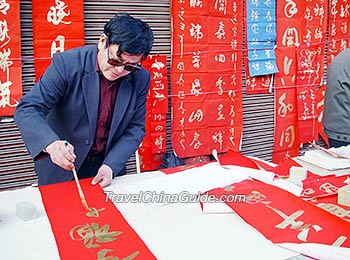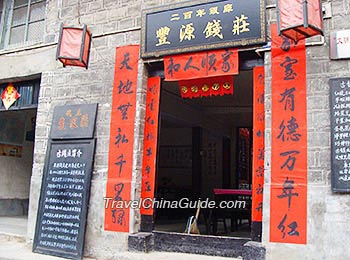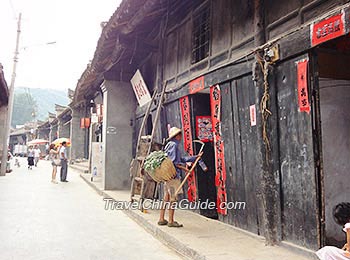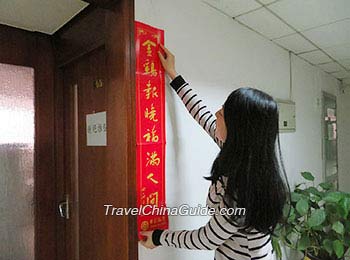Spring Festival Couplets (Chunlian)
Spring Festival Couplets, Chunlian in Chinese, is also known as Spring Couplets or Chinese New Year Couplets. It is the most common and important custom when celebrating Chinese New Year. This tradition is widely kept both in modern cities and rural areas of China.
What are Spring Festival Couplets?
 With black or golden characters written on red paper, Spring Festival Couplets are composed of a pair of poetry lines vertically pasted on both sides of the front door and a four-character horizontal scroll affixed above the doorframe. Pasting couplets expresses people’s delight in the festival and wishes for a better life in the coming year.
With black or golden characters written on red paper, Spring Festival Couplets are composed of a pair of poetry lines vertically pasted on both sides of the front door and a four-character horizontal scroll affixed above the doorframe. Pasting couplets expresses people’s delight in the festival and wishes for a better life in the coming year.
Features
The first line (upper scroll) and the second line (lower scroll) have parallel structures and antithetical meanings. The two lines should have an equal number of characters, while their meaning must be related and antithetical. There must be a one-to-one correspondence between the two lines. The tone pattern is emphasized but rhythm is not important. The horizontal scroll is a four-character phrase, which sums up the two lines’ meaning.
Legend and History
Spring Couplets originated from Taofu, an inscription on boards made from peach trees in the Zhou Dynasty (1046 - 256 BC). According to the legend, in the ghost world, a rooster perching in a big peach tree will crow at dawn to call all the traveling ghosts back. In front of the entrance of the dark world, there are two guards named Shentu and Yulei. If the ghosts harm any people at night, the guards will kill them as the tiger’s breakfast. People believed that peach trees can scare and subdue evil things, so they hung peach boards in front of the doors with the guards’ names written or inscribed on them.
During the Song Dynasty (960 - 1279 AD), the wood board was replaced by paper, and people focused more on bright wishes for the future. The custom became popular in Ming Dynasty (1368 - 1644 AD). When the Emperor Zhu Yuanzhang traveled for inspection, he found those pairs of scrolls interesting. In order to advocate and promote this cultural activity, he ordered all household to paste the scrolls during the Chinese New Year. This tradition continues today.
How to Read the Spring Festival Couplets?
 The order in traditional Chinese writing is different from that in western countries or modern China. In the past, people were accustomed to writing in vertical lines from right to left. The traditional couplets followed this rule, but things have changed. Sometimes people don't follow the rules, and they even make mistakes. Here is the way to read Spring Festival Couplets:
The order in traditional Chinese writing is different from that in western countries or modern China. In the past, people were accustomed to writing in vertical lines from right to left. The traditional couplets followed this rule, but things have changed. Sometimes people don't follow the rules, and they even make mistakes. Here is the way to read Spring Festival Couplets:
First, look at the horizontal scroll. If the four characters are written from left to right, the upper scroll will be on the left and the lower scroll on the right. If the characters of the horizontal scroll are reversed, the two side scrolls should be read from right to left.
How to Paste?
Pasting couplets is not an easy job. There are requirements for both when to paste and the correct order. Usually, they should be pasted before New Year’s Eve, and the best time is between 13:00 and 15:00 on the 29th of lunar December. The correct pasting order is: upper scroll → lower scroll → horizontal scroll. You can distinguish the upper and lower scrolls from the writing order of the horizontal scroll.
How to do with Old Couplets?
 There are rules not only for pasting the couplets, but also traditions for how to remove them, and these traditions vary in different areas of China.
There are rules not only for pasting the couplets, but also traditions for how to remove them, and these traditions vary in different areas of China.
In remote or rural areas, people will not remove the old scrolls until the next New Year. Although they are damaged by wind and rain, they will still keep them up until replaced the following year. In modern cities, if the couplets are ruined or damaged, people usually tear them off after the Lantern Festival. Some will just throw them away, while others will burn them. According to legend, Spring Couplets are gods. After burning, the god can go back to heaven, which will bring good luck to the family.
Handwritten Couplets or Printed Ones?
Nowadays, the most commonly seen couplets in China are printed ones. People usually purchase the printed ones 5 – 10 days before New Year's Eve. Banks and supermarkets will also present printed ones to their customers. Printed ones are cheap and convenient, but are still delicate and colorful in design and decoration.
Traditional couplets are done with ink and brush, and require excellent calligraphy skills that not everyone has. Only a few calligraphers are able to do a brilliant job. Before the New Year, the handwritten ones can be still found in some local markets, where people can choose their favorite lines and ask the calligrapher to write them. The essence of the couplets is demonstrated by the implicit good meaning and stylish calligraphy work. The printed ones lose both of these qualities. No only do they lack good calligraphy, but most of them have very bold and vulgar wishes for wealth and power.
 |
| Pasting Couplets for Chinese New Year |
Examples of Spring Festival Couplets
上联:丹凤呈祥龙献瑞 [dān fèng chéng xiáng lóng xiàn ruì]
下联:红桃贺岁杏迎春 [hóng táo hè suì xìng yíng chūn]
横批:福满人间 [fú mǎn rén jiān]
Upper Scroll: Dragon and phoenix bring the prosperity
Lower Scroll: Peach and apricot blossoms welcome the spring
Horizontal Scroll: Blessing on the Land
上联:红梅含苞傲冬雪 [hóng méi hán bāo ào dōng xuě]
下联:绿柳吐絮迎新春 [lǜ liǔ tǔ xù yíng xīn chūn]
横批:欢度春节 [huān dù chūn jié]
Upper Scroll: Red plum’s bud stands the snowy winter
Lower Scroll: Green willow’s catkin indicates the new spring
Horizontal Scroll: Happy Spring Festival
上联:春雨丝丝润万物 [chūn yǔ sī sī rùn wàn wù]
下联:红梅点点绣千山 [hóng méi diǎn diǎn xiù qiān shān]
横批:春意盎然 [chūn yì àng rán]
Upper Scroll: Spring rain nourishes the plants
Lower Scroll: Red plum decorates the mountains
Horizontal Scroll: Spring in the Air
上联:事事如意大吉祥 [shì shì rú yì dà jí xiáng]
下联:家家顺心永安康 [jiā jiā shùn xīn yǒng ān kāng]
横批:四季兴隆 [sì jì xīng lóng]
Upper Scroll: May you have good luck in everything
Lower Scroll: May you feel content and your family healty
Horizontal Scroll: Flourishing in Four Seasons
上联:迎新春江山锦绣 [yíng xīn chūn jiāng shān jǐn xiù]
下联:辞旧岁事泰辉煌 [cí jiù suì shì tài huī huáng]
横批:春意盎然 [chūn yì àng rán]
Upper Scroll: Ring in the spring; landscape is splendid
Lower Scroll: Ring out the past; everything is glorious
Horizontal Scroll: A Refreshed Spring
上联:春归大地人间暖 [chūn guī dà dì rén jiān nuǎn]
下联:福降神州喜临门 [fú jiàng shén zhōu xǐ lín mén]
横批:福喜盈门 [fú xǐ yíng mén]
Upper Scroll: Spring returns; the land becomes warm
Lower Scroll: Luck arrives; the people become cheerful
Horizontal Scroll: Luck is Coming
上联:精耕细作丰收岁 [jīng gēng xì zuò fēng shōu suì]
下联:勤俭持家有余年 [qín jiǎn chí jiā yǒu yú nián]
横批:国强民富 [guó qiáng mín fù]
Upper Scroll: Hardwork makes a harvest year
Lower Scroll: Thrift gains a handsome savings
Horizontal Scroll: Strong Country, Wealthy People
上联:迎新春事事如意 [yíng xīn chūn shì shì rú yì]
下联:接鸿福步步高升 [jiē hóng fú bù bù gāo shēng]
横批:好事临门 [hǎo shì lín mén]
Upper Scroll: Everything goes well as you expect
Lower Scroll: Career rises steadily as you want
Horizontal Scroll: Luck Knocks on the Door
上联:万事如意展宏图 [wàn shì rú yì zhǎn hóng tú]
下联:心想事成兴伟业 [xīn xiǎng shì chéng xīng wěi yè]
横批:五福临门 [wǔ fú lín mén]
Upper Scroll: Expand blueprint with everything accomplished
Lower Scroll: Achieve success with ambition fulfilled
Horizontal Scroll: Luck Rings In
上联:冬去山川齐秀丽 [dōng qù shān chuān qí xiù lì]
下联:春来桃李共芬芳 [chūn lái táo lǐ gòng fēn fāng]
横批:辞旧迎新 [cí jiù yíng xīn]
Upper Scroll: Winter ends in splendid mountain and river landscape
Lower Scroll: Spring starts from fragrant peach and plum blossom
Horizontal Scroll: Ring out the Old; Ring in the New
Note: In some rural area, the couplets in yellow, green or purple can also be seen, which suggests that a household has family members passed away in three years, and it is a special custom to mourn for them.